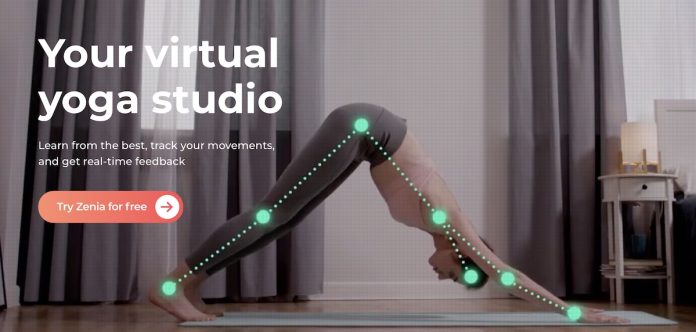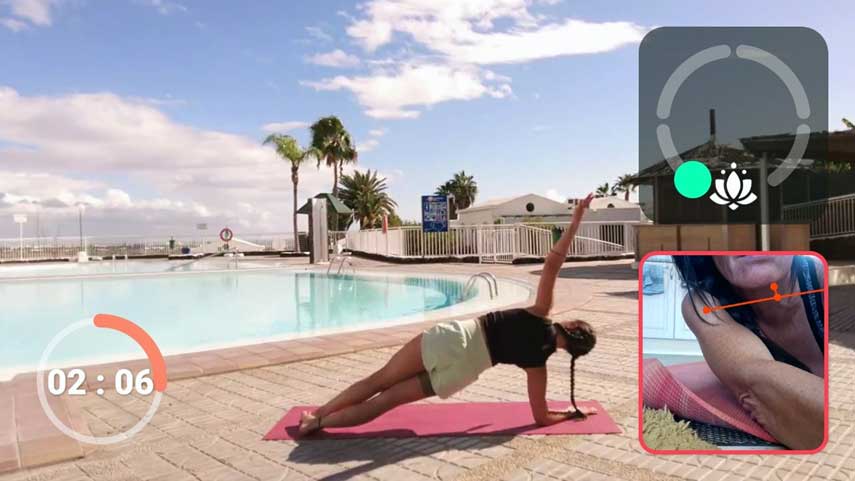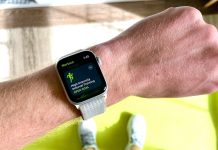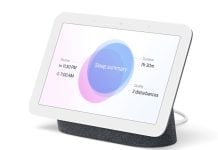While I appreciate Zenia pushing the boundaries of what Yoga apps can do and track, I don’t think it’s ready for prime time, especially for people with injuries or health issues. In particular, as a physiotherapist, I am concerned with safety, the lack of asana (pose) modifications, and limited instruction on how to get into and out of the pose or make transitions between poses.
Although some yoga practitioners, especially healthy adult beginners, may appreciate and enjoy how the Zenia app tracks their movements in real-time using their mobile phone’s camera as well as the post-class tips and analytics to improve, for a long time practicing Yogis like me, the daily practices and insights offered in Zenia are just too simple!
Overall, Zenia is promising but, at this time, does not replace live assistance provided by a trained instructor-led Yoga studio.
Contents
Related reading
- Yoga teacher recommends these 9 apps for iPhone and Apple Watch
- Is Lungy the best breathing app for iPhone? Here’s what to know
- Improve breathing and reduce stress using Breathe Flow app on your Apple Watch
About Zenia’s app
This app is promoted as your virtual yoga teaching assistant, offering the first yoga app that uses your mobile phone’s camera to track your asanas in real time using AI and provides you with personalized feedback on your poses.
Using your phone’s front camera set about 6 feet away from your workout space, the app uses AI and motion tracking to recognize movements of your body’s major joints and gives real-time feedback and personalized guidance on the practice quality to help improve your yoga poses.
While the app streams in real-time, nothing is recorded or saved.
Ideally, the Zenia app helps participants learn where they make pose mistakes or have weaknesses and shows them how to correct or strengthen them.
Zenia works on iPhones running iOS 14 and above and Android phones running Android 8.0 and with at least 2GB of storage.
How Zenia works
You must place your phone using the front-facing camera angled toward the space where you’ll be doing yoga. You see several things on your screen:
- Video of yourself
- Dots and a circle that turns green if you progress correctly in the pose or another color (red, yellow) if incorrect.
- A timer.
Your body is video-mapped and represented by straight lines that signify a basic skeleton with dots that indicate the main joints.
If you align correctly in the asana (your body map matches the pose demonstrated), the lines and dots are green.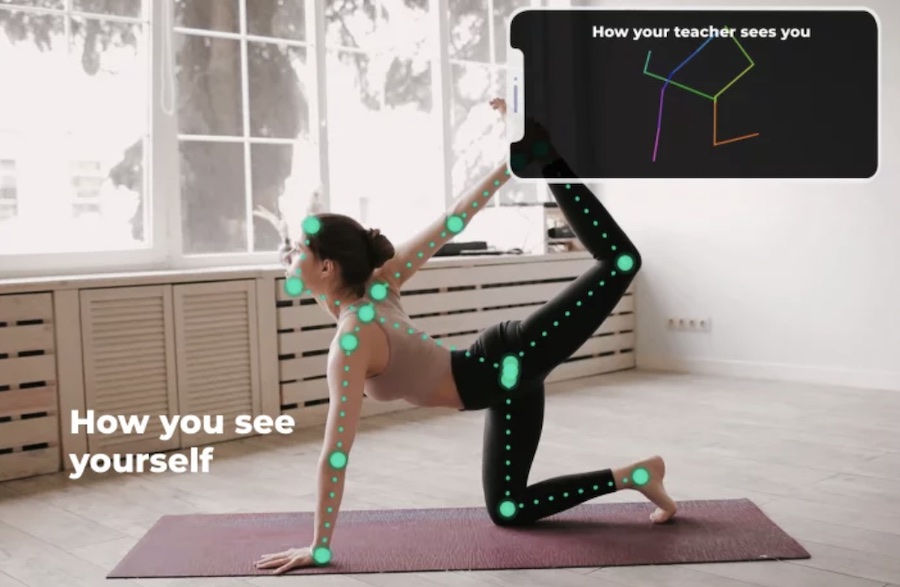
If you are not in proper alignment, the lines and dots are red, as shown in the screenshot.
Set-up Zenia
After installing the app, you create an account. You are asked various questions about your fitness level, goals, and health. You have to choose a subscription/ free trial option.
If you subscribe annually, you have a 14-day free trial; if you choose the monthly subscription option, you have a 3-day full trial.
Once registered, you can choose a workout reminder to add to your calendar.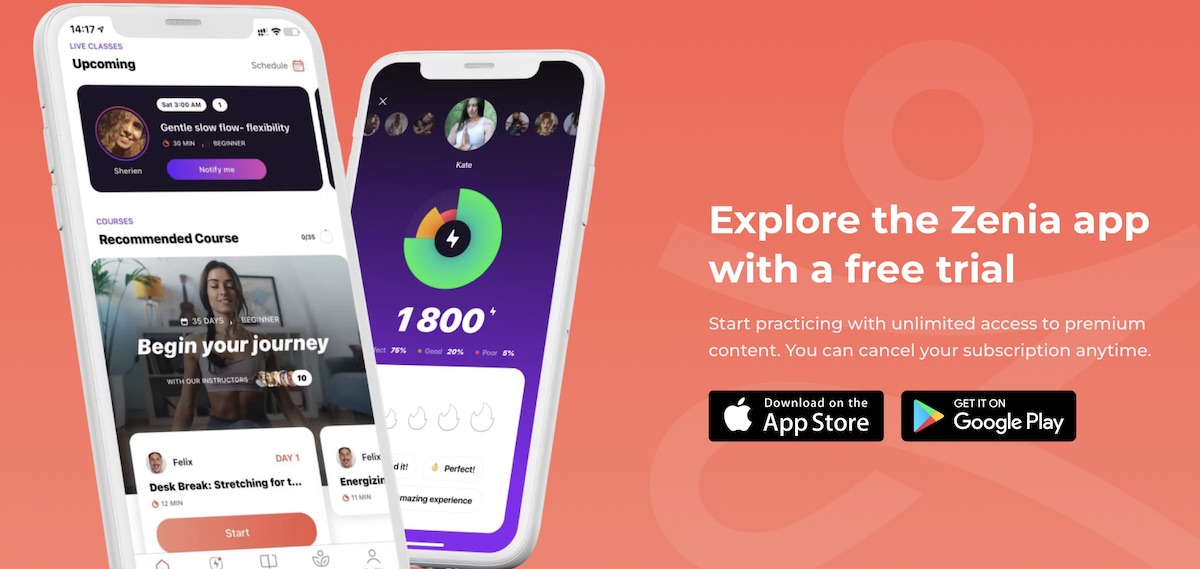
Classes offered in Zenia
You are given a series of recommended classes, and you can also choose from live courses and explore other themed classes.
Zenia’s feedback for users
Following completion of your yoga classes, you are given personalized feedback.
As seen on the screenshot, every asana has a circle representing your progression in the asana.
If you have completed the asana correctly, the circle is complete and green; if you did not correctly, it is represented by a yellow incomplete circle.
You are awarded points and best result points.
My personal Experience using Zenia’s Yoga app
This app would not be my preferred choice of yoga apps. Here are the reasons why.
Technical issues
The app crashed twice during the initial setup and twice while I was practicing a class, so I had to start the setup again from the beginning.
And more frustratingly, I had to start the class from the beginning twice.
Choice of live classes
I was interested in trying a live class, but I could not find a class I could join due to my work commitments. Meditation classes were available early, but no classes were at 8 p.m. or later.
Unlimited live stream classes are offered for premium subscription members. Those without a premium subscription can join a total of three live classes before they become premium members.
Asanas
The recommended classes repeated the same asanas with one or two different ones. You are not given any modifications during the asanas.
For example, if you can’t do downward dog, do cat pose instead, or rest if you need to, if the pose is too difficult.
Also, making the asana more difficult was impossible if you wanted to challenge yourself.
One of my main reasons for doing yoga is to stretch my whole body, particularly my back, but none of the classes included asanas that targeted spinal rotations.
Finally, there is no real flow between poses. You start in one pose and then move to the next without the usual physical transition between asanas.
Relaxation
My yoga classes didn’t include awareness of the breath or relaxation at the end of the class–practices I always enjoy at the end of a session.
The screen is also very busy, and the pace of the videos is relatively fast.
Combining these things made my practice feel stressful rather than relaxing and calming. I practice yoga to de-stress. I didn’t feel I achieved this with the classes that were recommended for me.
Most people like me begin yoga for exercise and stress relief (1), and multiple studies have shown that yoga can decrease cortisol, the primary stress hormone (2). This app should consider the principal reasons why people practice yoga and adjust the class parameters accordingly.
Position of your phone 
The distance and positioning of the phone from your mat make it difficult to see your phone screen and watch the AI simultaneously. Placing your phone about 6 feet (2 meters) away makes it very difficult to see the screen and see what’s going on, especially if you are new to the pose!
For a larger screen experience, you can AirPlay or Chromecast from the Zenia app to a larger screen, if available, and if the TV supports AirPlay/Chromecast.
You cannot change the position on the mat to match the instructor because the AI is only 2D and not 3D, and your body position is shown as incorrect.
So, I found myself trying to turn my head in postures to follow the video, which I found uncomfortable and awkward.
This could also lead to injuries for beginners unfamiliar with poses (i.e., trying to turn one’s head while in downward dog to see if you’re doing it properly; it could cause an injury). A survey of 34 countries in 2007 found that practicing yoga incorrectly generally causes neck injuries (3).
Pros and Cons as a Zenia app user
Pros
- Motivational with direct and personalized feedback
- Live classes and choice of on-demand classes
- Offline mode when you download classes to your phone
- Has a calendar reminder
- Good for healthy beginners with no injuries
- You can use the app on other phones or tablets signed in with the same Apple ID or Google account. Cannot share subscriptions between Apple and Android.
- The company listens to user feedback and updates the app frequently
Cons
- Cost. Needs a paid and auto-renewing subscription
- You can only purchase on your mobile device via Apple’s App Store or Google Play Store.
- The app kept crashing for me
- Limited choice of live class times
- Lacks modifications for poses
- Lacks detailed instruction
- Busy screen
- It needs more instructors and classes with increasing difficulty levels
Reviewing Zenia as a physiotherapist (physical therapist)
Set up & yoga practice prescription
The questions during the setup did not appear specific enough to prescribe a yoga routine for people with health conditions or injuries.
When asked about my fitness level in the setup, I chose dedicated to health and fitness, and when asked about my activity level, I decided strenuous.
When asked about health conditions, I chose chronic conditions/ digestive disorders. It did not give an option for I’m healthy, and there was no option to add other conditions such as musculoskeletal disorders like arthritis or neurological disorders like multiple sclerosis (MS).
These are both conditions that would require different adaptations in the poses.
For example, someone with knee arthritis may not do a child’s pose or cat/cow with weight bearing on the knees or maximum knee flexion. Someone with MS may be unable to do a sun salutation because they may not get up and down from the floor.
My recommended sessions did not give options or modifications for any of the poses in the video. There was no choice but to alter the time of practice. I was given a 10-minute practice, which was fundamental, although I had put my fitness levels as strenuous.
Thus, the setup questions did not match the yoga practice I was given.
It is possible for someone with a chronic condition to exercise strenuously but still need adaptions, for example, someone with ankylosing spondylitis. People with this condition can improve with exercise but must be mindful of how that exercise affects the spine. Therefore, someone with this condition may be active but have limited spinal movements.
The setup also included what seemed to be irrelevant questions, such as what workout equipment you have at home.
Although it missed out on important factors, such as the fitness goals did not have an option of improving flexibility or de-stress, these are the main reasons people choose to start yoga.
It also does not ask if you have practiced yoga before, an important factor in prescribing an exercise program.
Phone placement
The phone placement is very awkward, and it isn’t easy to see the screen.
I am only 1.5 m tall, and I think this app may be unusable for taller people because you have to stand far enough away from the phone for your whole body to be visible by the app.
Taller people would not see the teacher or the alignment mapping video or when the asanas are changing.
In this case, adjusting your posture to improve the asana would be difficult. Practicing yoga with incorrect postures can cause health problems, such as muscle sprains and pain (3).
AI Mapping
In principle, AI mapping is a good idea, but my personal use of the app did not function well enough to give valuable feedback during the yoga session.
I found it distracting and frustrating. The AI mapping would be more useful if it were more specific and 3D, not 2D.
During a standing side bend, I leaned too far forward by twisting at the hips, and the AI did not indicate any changes in my posture.
I tried several incorrect movements, which the AI did not register. Then, I lifted my leg to the side during the bend, which Zenia finally indicated as incorrect.
Therefore, only large gross 2D movements were sufficient to elicit a response from the AI mapping. Yoga mobile applications may be a convenient way for beginners to start a yoga routine, but there is a lack of research on using these apps, including injuries sustained (4).
Quality of Instruction
As mentioned earlier, no modifications were given during the class, which is an essential part of instruction, especially for beginners.
Research studies indicate that improper yoga positions can cause sprains of the neck, shoulder, wrist, knee, and muscular pain. Studies show that most injuries are lower limb sprains (5).
Thus, people practicing at home, especially beginners without suitable instruction, may be more likely to injure themselves.
Final thoughts
While this app may be helpful to people who are physically fit and are not likely to injure themselves, I find that there are insufficient set-up questions to be able to prescribe a yoga practice for people with health conditions.
A disadvantage of AI mapping and integrated feedback is it creates a very busy screen, and the placement of the phone makes it a stressful experience rather than a distressing experience.
Watching and following the AI mapping distracted me from my yoga practice. It didn’t create an atmosphere of calm or relaxation.
This app creates a busy phone screen during your practice, which doesn’t allow the stillness and connection between your body and breath from practicing yoga.
I’d like to see some updates to the app, including 3D mapping, improved mapping, and a much better screen organization.
I’d also like to see more in-depth setup questions, especially for people with injuries or health conditions. A program prescription would improve the users’ experience and reduce the risk of injuries.
If interested, Zenia offers a 2-week free test drive trial when you sign up via the App Store or Google Play Store–just remember to cancel 24 hours before that free period ends!
References
- Park CL, Riley KE, Bedesin E, Stewart VM. (2016) Why practice yoga? Practitioners’ motivations for adopting and maintaining a yoga practice. Journal of Health Psychology. 21(6):887-896. doi:10.1177/1359105314541314.
- Vedamurthachar A, Janakiramaiah N, Hegde JM, Shetty TK, Subbakrishna DK, Sureshbabu SV, Gangadhar BN. (2006) Antidepressant efficacy and hormonal effects of Sudarshana Kriya Yoga (SKY) in alcohol-dependent individuals. J Affect Disord. Aug;94(1-3):249-53. DOI: 10.1016/j.jad.2006.04.025. Jun 5. PMID: 16740317.
- Fishman L, Saltonstall E, Genis S (2009) Understanding and preventing yoga injuries. Intern J Yoga Therapy 19:47–53.
- Sotolongo, Patricia (2020) Yoga Mobile Applications: Use, Adherence, and Mental Health. Alliant International University. ProQuest Dissertations Publishing, 2020. 28087366.
- Russell K, Gushue S, Richmond S, McFaull S (2016) Epidemiology of yoga-related injuries in Canada from 1991 to 2010: a case series study. Int J Inj Contr Saf Promot 23:284–290. https://doi.org/10.1080/17457300.2015.1032981

